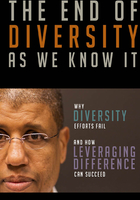
Managing Diversity Wasn’t Designed for Long-Term Change
Managing Diversity activity was always built for the short run. It is triage work. You see a demographic crisis in workforce makeup (a crisis that was and continues to be heightened by rapid demographic shifts in the labor market) and you respond by identifying steps that will head off that crisis. That’s what targeted recruiting and hiring and quotas are all about. But now we find ourselves living in a complex global economy in which coming up with sustainable solutions, not just temporary fixes, is what’s needed. You can’t follow the Managing Diversity tactic of ratcheting up recruitment of “diverse” people without solving the problem of why those same people continue to leave more frequently than their majority counterparts. “Let’s get people in the door and see what happens” is just not good enough anymore. Managing Diversity efforts are thus often unsustainable; they don’t really create the kind of change that businesses and society need to remain economically competitive and socially just.
Most companies and leaders who are genuinely engaged in diversity work are looking for sustainable improvement in firm performance. But that consistent, long-term change in the way business is done is likely to be elusive if their efforts remain grounded in traditional diversity practices. First of all, Managing Diversity is, at its core, crisis-driven. Many companies have undertaken diversity work either in anticipation of or in reaction to external pressures such as discrimination litigation. David Pitts and his colleagues found as much when they surveyed a representative sample of organizations that were engaged in traditional diversity efforts. In an effort to understand whether the work was motivated by external pressures likely to precipitate crises, they found that such pressures were, in fact, among the strongest drivers for Managing Diversity programs.
A hallmark of traditional diversity work is that it is “add-on” activity—tactical work that people undertake in addition to their regular jobs. So it isn’t surprising that it takes an urgent situation to mobilize action. This is exactly why traditional diversity is so frequently crisis-driven. That crisis may be acute (“We’re being sued!”) or chronic (“We have to hurry to stay ahead of demographic changes!”). Either way, operating in crisis mode encourages tactical actions that often lead to short-lived changes.
Furthermore, traditional diversity approaches typically promote a menu of metrics and incentives designed to generate visible and timely results. But the unintended consequence is that diversity stakeholders are motivated to keep producing “quick-win” approaches that perpetuate short-term change without requiring long-term transformation. For example, the impetus to implement a diversity initiative (created by the crisis of a lawsuit) prompted FedTech Technologies,* a computer manufacturing company, to establish an incentive for hiring persons of color. If managers failed to do so, their year-end bonuses suffered (in fact, the company had created a disincentive to lead a team without anyone of color on it). As a result, managers rabidly sought out candidates and began to hire them. Within eighteen months of the mandate, representation of managers of color had increased. However, those managers were disproportionately represented in the lower ratings of performance, making them more vulnerable to turnover.
Similarly, Aeolian Accounting* faced a serious dilemma in 1997. For years the small auditing firm had lagged behind competitors in advancing women into partnership positions. Its pipeline was anemic, as it had relatively few women associates in the firm. The unspoken rationale had been that since it was lean, it couldn’t afford to make “mistakes” in hiring, so it had followed a conservative strategy of hiring from familiar pools of talent. The result was that the vast majority of associates were men. In a bold move, CEO Alan Jerrold* declared that for the coming fiscal year, only women associate hires would be approved. Jerrold was pleased that six women joined the firm that year, compared to only one the previous two years combined. But when he took stock of the situation in 2008, he was discouraged. By this time many of the women who had entered in 1997 should have become partners. But none of them had been promoted to partner.
The cases of FedTech and Aeolian are similar in two ways. In the first place, both organizations implemented a hiring initiative based primarily on a demographic characteristic. Both initiatives were driven by the organization’s anxiety over a diversity crisis. Second, managers were given the directive to hire people of color and women with no guidance on how to create an environment in which they could be successful. The resulting demographic disparities had occurred because of the exclusionary nature of the organizations’ culture and practices. It made little sense to bring in members of groups who had traditionally struggled in that culture and expect them not to face the same challenges in that same culture.
Traditional diversity relies heavily on relatively simple measures such as an organization’s current demographic profile and how it has evolved over time, specifically data related to recruiting (who was interviewed, who was hired), promotions (who was considered, who was promoted), and retention (who left the organization, how turnover rates compare across demographic groups). The other common approach is to use employee opinion data as a way to evaluate the effectiveness of a diversity initiative. Surveys, focus groups, and exit interviews can be used to monitor more subtle and systemic aspects—organizational culture, for instance, and barriers such as lack of mentoring programs and exclusion from informal networking groups.
The question is whether these metrics do an adequate job of measuring what matters most in generating long-term change. How will the head count of people with different demographic characteristics really help an organization create sustainable change? How will attitudinal surveys support the behavioral changes that would make a difference? These questions must be answered if long-term sustained change is the goal.